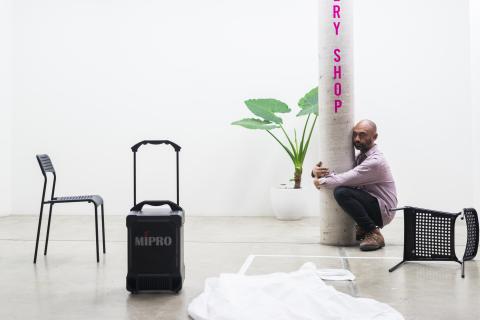eX de Medici | Artist
By The Last Word
Artlines | 4-2020 | December 2020
Each issue of Artlines, we invite an artist, curator or art lover to share their practice and passions with us. For our final issue of 2020, we spoke with senior Australian artist, Foundation member and ‘Full Face’ participant, eX de Medici.
What art do you most identify with?
Medieval, Baroque, Islamic.
What’s your favourite part of the creative process?
From beginning to completion.
What research do you do?
Experts, National collections, National Library of Australia, books, academic friends, Internet to a minor degree.
Where are you finding ideas for your work at the moment?
The CSIRO, working with the New Guinean microlepidoptera field collections of my long-term mentor and friend, evolutionist and taxonomist Dr Marianne Horak.
What, if anything, gets in the way of making art?
Unexpected, uncontrollable Life.
What do you do when you’re not feeling inspired?
I work on things that make me laugh . . . silly personal projects that I call ‘Things I Do When I’m Not Doing Anything’. Walking with the dog and friends in the bush. Playing around in the garden. Practising scales, chords and arpeggios on my old beat-up classical guitar. Going for a drive in my drift car. Qigong training.
What memorable responses have you had to your work?
A quote from the Mornington Peninsula Regional Gallery visitors’ book that said: ‘This show makes me feel sick’. Perfect: I felt sick making it.
What role does arts funding have?
Arts funding is imperative for the development of young and emerging artists. This assistance can change the lives and trajectories of people beginning their life in art.
What has been your experience of artistic collaborations?
Love them! Invigorating.
How often do you visit art galleries or museums?
As often as I can.
What work of art do you wish you owned?
An almost impossible question, but here are a few of the unattainable: A thirteenth-century Qur’an, on vellum, using only three colours — black, ultramarine and gold leaf — housed in a small out-building of the Vakil Mosque in Shiraz, Iran; Hans Holbein the Younger’s Ambassadors 1533 (National Gallery, London); Géricault’s The Raft of the Medusa 1818–19 (Louvre, Paris); [Austrian botanical illustrator] Ferdinand Bauer’s Drosera binata, forked sundew 1801 (Natural History Museum, London); and John Webber’s Portrait of Poedua, daughter of Orio, chief of Ulietea, Society Islands c.1782–85 (National Gallery of Australia, Canberra).
What under-appreciated artist/gallery/work do you think people should know about?
The work of Aslan McClennan.
What international art destination do you most want to visit?
Always Iran. And not international but of singular global importance and a long-desired destination, the ancient rock art galleries of Murujuga — also known as the Burrup Peninsula — in north-western Australia (before gas corporations blow it to smithereens).
Which historical figure do you most identify with?
A burning witch.
Which living person do you most admire?
These questions are too big! Greg Combet.
Name three people you’d invite to a dinner party.
Judge Joe Dredd, Silvio Orlando, Roberto Calasso.
Where would you most like to live?
Isfahan, Iran.
Where did you grow up, and how do you think this has influenced your practice?
I grew up in Canberra. It is a primary influence: I critique constructs of power.
What jobs have you had, other than being an artist?
Worked on Tony Ayres’s first film, in an artist-run gallery, designed posters and T-shirts for bands and theatre companies, designed a campaign for the AIDS Action Council in 1989, tattooed thousands of people.
What’s your strongest memory of your childhood?
Age 4. Wading knee-deep through Riverina bulldust with my four siblings in a kangaroo line, looking for a life-sized Virgin Mary’s head after it was snapped off its painted plaster body by the boot lid of our grandfather’s gold, spoke-wheeled Holden HT Brougham.
What’s the best piece of advice you’ve been given?
‘You had better thicken your skin up if you want to survive the art world’ — advice given by an elderly Sid Nolan at Bundanon in 1984.
What couldn’t you do without?
Car and sunglasses.
What is your greatest extravagance?
Cars, books, classic parfum, travel.
Which talent would you most like to have?
Music and charm.
What do you most value in your friends?
Humour and kookiness.
What, if anything, do you listen to while you work?
A never-ending list, but here are a few: Mahler, Hoods, Queen Latifa, George Michael, Segovia, Hanggai, Lindy Ortega, and currently, the soundtracks to Paolo Sorrentino’s The Young Pope and The New Pope.
Feature image: eX de Medici’s Gun(n)s ’n Styx 2005, installed for ‘eX de Medici: Beautiful Wickedness’, GOMA, September 2023 / Collection and © The artist / Photograph: J Ellis, QAGOMA
Related artists
de MEDICI, eX
1959
- present
Full profile
for de MEDICI, eX
Metadata, copyright and sharing information
About this story
- Subject
